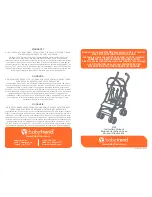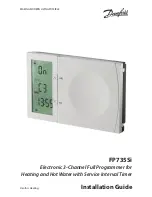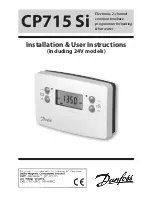
EN-5
EN-5
EnGLisH
En
B
A
1
2
1
1
1
1
5
6
3
3
3
4a
4b
Sample architecture using several NTC controllers
4.2.1 - Points to follow for the bus cable routing
•
The bend radius must be higher than 20 times the
cable diameter.
•
Avoid looping of the earth cable. Place the cable on
metallic structures.
•
The controller connection to the bus can be made
with a cable extension, if required. All extensions
must be as short as possible, and must never exceed
1.5 m.
Normal bus connection
Acceptable extension: max. 1.5 m
Controllers
3.2 - System architecture - controller addressing
The communication bus complies with standard RS 485.
The default communication speed is 38400 bauds. The
minimum speed is 9600 bauds.
The maximum total bus length for the specified cable is
550 m. The communication protocol for the system bus is
the Carrier Comfort Network (CCN). The units are
connected along the length of a single bus cable that is
mounted in cascade between the units.
The NTC controller addresses are configured by the soft-
ware with the Carrier parameter tool. An NTC controller
includes two NTC sub-controllers each with a CCN address.
It can have up to 192 different addresses (1 to 192) on the
CCN bus; that means 96 NTC controller boxes that can be
connected to the CCN bus.
IMPORTANT: Carrier recommends the use of the following
specific cable (or equivalent) the communication busses:
BELdEN cable 9842 (not supplied by Carrier).
4 - INSTAllATION
4.1 - Installation instructions
IMPORTANT: For each power cable entering or leaving the
controller a maintenance and locking system is provided.
This maintenance system depends on the chilled beam
supplied with the controller.
4.2 - Physical and electrical characteristics
Operating temperature:
0°C to 50°C
Operating humidity:
10 to 95% at 50°C (non-
condensing)
Controller protection index:
IP 20
Controller fixing on chilled beam: done at the factory
•
Ensure that the earth potential is the same everywhere.
•
Connect one of the ends of the bus cable shielding
(only one) to the earth. The distance between the
shielding and earth must be as short as possible.
•
Ensure that the cable shielding continuity is guaranteed
along its whole length.
•
If the earth potential between the controllers is the
same, it is better to connect both ends of the bus cable
shielding to earth.
•
To avoid any reflection in long cables, it is recommended
to add an end-of-line impedance at one end of the bus.
The end-of-line impedance should be the same as the
characteristic nominal impedance for the selected cable
(120 ohms for the specified Belden cable). It will be
connected between the “+” and “-” terminals on the
last bus unit. It is important that the end-of-line
impedance and the characteristic cable impedance are
as similar as possible. If the network only has a short
distance, the end-of-line impedances can be left out
without effect on data transmissions.
•
It is important to connect the “+” and “-” terminals of
the bus cable on the same twisted cable pair (4.3.3 -
Communication bus connection).
Legend
1
NTC controller
2
CCN communication bus
3
User interface connection
4a Infrared receiver
4b IR2 infrared remote control
5
ZUI2
6
Power Module II (PMII)
A Room A
B Room B














































